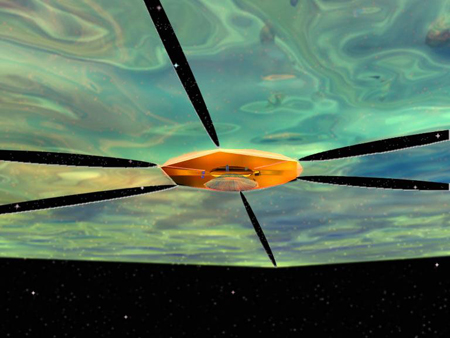
Back to the Space Place Index
Far-out
Ideas
by
Patrick L. Barry
Ever had a
great idea for a new spacecraft propulsion system, or for a new kind
of Mars rover? Have you ever wondered how such "dinner napkin
sketches" evolve into real hardware flying real missions out in
the cold blackness of space?
The road to reality for each idea is a unique story, but NASA has
defined some common steps and stages that all fledgling space
technologies must go through as they're nursed from infancy to
ignition and liftoff.
Suppose, for example, that you've thought of a new way to shield
astronauts from harmful radiation during long space missions. In the
first stage, you would simply "flesh out" the idea: Write it
down, check the physics, and do some quick experiments to test your
assumptions.
If the idea still looks good, the next step is to build a "proof
of concept." This is the "science fair project" stage,
where you put together a nifty demonstration on a low budget-just to
show that the idea can work.
For your radiation-shielding idea, for example, you might show how a
Geiger counter inside a miniature mock-up doesn't start clicking when
some radioactive cobalt-60 is held nearby. The shielding really
works!
Once that hurdle is cleared, development shifts into a higher gear. In
this stage, explains Dr. Christopher Stevens of JPL, the challenge
isn't just making it work, but making it work in space.
"Some
conditions of space flight cannot be adequately simulated here on
Earth," Stevens says. Cobalt-60 doesn't truly mimic the diverse
mixture of radiation in space, for example, and the true microgravity
of orbit is needed to test some technologies, such as the delicate
unfolding of a vast, gossamer solar sail. Other technologies, such as
artificial intelligence control systems, must be flight tested just
because they're so radically new that mission commanders won't trust
them based solely on lab tests.
Stevens is the manager of NASA's New Millennium Program (NMP), which
does this sort of testing: Sending things to space and seeing if they
work. In recent years the NMP has tested ion engines and
autonomous navigation on the Deep Space 1 spacecraft, a new
"hyperspectral" imager on the Earth Observing 1 satellite,
and dozens of other "high risk" technologies.

This is just one idea of how a solar sail could be
used to power an interstellar probe. A solar sail is one
possible type of new technology that NASA's New Millennium Program
would test in space before it would be risked on a scientific
mission.
Thanks to the NMP, lots of dinner napkin sketches have become real,
and they're heading for space. You can learn more at the NMP
website, nmp.nasa.gov/.
This
article was provided by the Jet Propulsion Laboratory, California
Institute of Technology, under a contract with the National
Aeronautics and Space Administration.
|
About LUNAR |
Home |
Calendar |
Contacts |
Old Gallery |
Member Pages |
Events |
Presentations & Docs |
LUNAR'clips |
Handbook |
Space Place |
Mailing Lists |
Joining |
Other Rocketry Pages |
Site Map |
Frames |
All content is the responsibility of LUNAR.
If you have comments or suggestions regarding these web pages,
please contact the 
Copyright © 1992 - 2025 LUNAR


